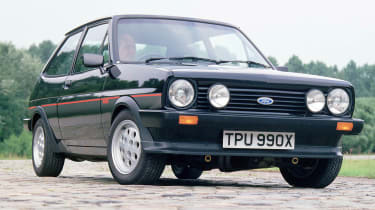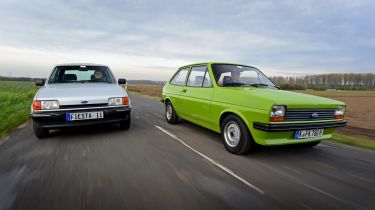Complete Ford Fiesta review: every generation tested as production ends
As the last-ever Fiesta rolls off Ford’s production line, we take a look back at this iconic small family supermini testing every version
After 47 years in production, today marks the end of the line for Ford’s iconic Fiesta supermini, as the last ever model rolls out of the factory in Cologne, Germany.
The Fiesta has been one of Ford’s most popular cars with British buyers for decades, with more than 4.8 million examples finding homes in the UK and approximately 1.5 million Fiestas of all generations currently registered for use on the roads today. Unveiled first in 1976, the Fiesta has racked up 22 million sales globally, but now it’s being axed as Ford prepares to launch an all-new electric crossover as its range entry model.
While many Ford fans may lament the Fiesta’s demise, the company historically hasn’t been scared of taking bold steps in removing popular cars from its line-up; Some drivers will still be scarred by the loss of the Escort in the year 2000, and more recently the Mondeo disappeared from showrooms.
The last two Fiesta models to leave the Cologne factory will be kept by the carmaker for posterity, and will include a right-hand drive example that will join the Ford UK heritage fleet, we’re told.
So with the Fiesta era coming to a close, let’s take a look back at each and every generation of Fiesta and remind ourselves how this little supermini conquered Britain by providing transport for every taste and budget - from a frugal family runaround to a hairy-chested hot hatch.
The complete Ford Fiesta review
- Ford Fiesta Mk1 (1976-1983)
- Ford Fiesta Mk2 (1983-1989)
- Ford Fiesta Mk3 (1989-1997)
- Ford Fiesta Mk4 (1995-2002)
- Ford Fiesta Mk5 (2002-2008)
- Ford Fiesta Mk6 (2008-2016)
- Ford Fiesta Mk7 (2016-2023)
Fast Fiestas: a race through time
Ford first toyed with the idea of a faster Fiesta in the late seventies, when it entered a pair of Group 2 Fiesta rally cars into selected events for future world champion Ari Vatanen and British legend Roger Clark.
Used - available now

2018 Volkswagen
Up
50,500 milesManualPetrol1.0L
Cash £7,995
2016 Tesla
Model S
78,000 milesAutomaticElectric
Cash £18,999
2022 Toyota
Corolla Touring Sports
31,758 milesAutomaticPetrol1.8L
Cash £19,100
2018 MINI
5-Door Hatch
37,431 milesManualDiesel1.5L
Cash £9,963This led to 1980’s 1.3-litre Supersport, which was followed a year later by the XR2 – and the latter became an instant hit with its distinctive round headlamps, racy bodykit, ‘pepperpot’ alloys, stiffened suspension and 84bhp 1.6-litre engine.

As a result, Ford didn’t mess with the winning formula for the Mk2. The original engine was replaced by a more powerful 96bhp 1.6-litre CVH unit and the interior got a more upmarket look, but in all other respects the XR2 ignored sophistication and outright performance for fun and value.
The brand was more ambitious with the third-generation model. The addition of fuel injection meant a healthy 110bhp output – and a name change to XR2i – while a fresh front bumper with extra lights, plus blue piped trim, set the car apart. Ford also offered the hot RS Turbo, with 132bhp and 0-62mph in 8.2 seconds. Late in the Mk3’s life, both cars got the new 1.8-litre 16-valve twin-cam Zeta units, giving 104bhp in the XR2i and 128bhp in the renamed RS1800.

Thefts and rising insurance premiums meant that the hottest Mk4 Fiesta was the 101bhp Zetec-S, although suspension and steering tweaks from the Puma coupé made it great fun to drive. The 148bhp ST arrived with the Mk5 in 2004 and was a step in the right direction, but not until 2013’s current ST did Ford get its fast Fiesta mojo back.
The Fiesta ST is viewed by many company insiders to be the best fast Ford since the legendary nineties Escort RS Cosworth, and combines thrills with value.








